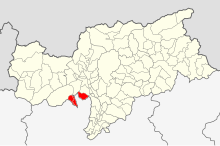Deutschnonsberg
As Deutschnonsberg (isolated German area on the Nonsberg , occasionally translated into Italian as Alta Val di Non ) three communities belonging to South Tyrol with a German-speaking population at the upper end of the Nonsberg or Non Valley are referred to. The other municipalities in this valley have an Italian-speaking population and belong to the Trentino .
The Deutschnonsberg villages are spread over two spatially separate areas and are part of the Burggrafenamt district community within South Tyrol . From the rest of South Tyrol you can reach it directly over the Gampenpass or the Hofmahdjoch , as well as - crossing a short stretch of the Trentino territory - over the Mendelpass .
As remote communities in South Tyrol, they have always been affected by emigration and poverty. Since the end of the 20th century, attempts have been made to upgrade the places by building a new road and the Leader and Leader Plus programs. The projects of the Leader program include the radicchio weeks and the dandelion weeks.
history
The Deutschnonsberg already appears in documents from the 14th century as a separate enclave from the Romanesque Nonsberg of Trentino . In a Latin legal record from 1359 with reference to the farms of the Laureiner Berg, there is express mention of a German loan law in use there ( "secundum usum consuetudinem Teotanicorum de montagne Lauregni" ). In Matthias Burglechner's Tyrol map from 1609, the area is referred to as "Auf dem Nonß" . The German-speaking area was evidently settled from the nearby Ulten Valley , which was easily accessible via the Hofmahdjoch , and originally went back largely to the initiative of the Counts of Eppan .
The Deutschnonsberg belonged to the county of Tyrol and thus to Austria-Hungary until the end of the First World War . With the Treaty of Saint-Germain , the Deutschnonsberg came to Italy in 1920 together with most of Tyrol south of the main Alpine ridge . When the two provinces of Bolzano and Trento emerged in these formerly Austrian areas in 1927, the Deutschnonsberg was added to the predominantly Italian-speaking province of Trento. It was not until 1948 that the German-speaking communities were incorporated into the province of Bolzano and South Tyrol.
In the 1960s, the Deutschnonsberg became the subject of cultural anthropological field research by the American and British ethnologists and geographers Eric Wolf and John W. Cole, who, with their study The Hidden Frontier, first published in 1974 for the Romance-Germanic cultural difference, used the catchy term of a " invisible border ”in the proposal. The differences are shown in particular in the different inheritance law , different marriage behavior and almost exclusively to South Tyrol-oriented migration compared to the Italian-speaking Nonsberg .
While the road over the Gampen Pass into the Adige Valley had been built in the 1930s and Our Lady in the Walde and St. Felix have had a direct connection to the South Tyrolean transport network ever since, Proveis and Laurein were only left with car traffic from the rest of South Tyrol for decades Detours accessible through Trentino territory. This only changed in 1998, when a new pass road including a tunnel under the Hofmahdjoch was inaugurated, thus opening a direct connection to the Ultental .
Communities
- Proveis (1420 m)
- Laurein (1150 m)
-
Our Lady in the Walde-St. Felix , consisting of the localities:
- Our Lady in the Forest (1350 m)
- St. Felix (1250 m)
Individual evidence
- ^ Egon Kühebacher: The place names of South Tyrol and their history . Vol. 2: The historically grown names of the valleys, rivers, streams and lakes . Bozen: Verlagsanstalt Athesia, 1995, p. 48. ISBN 88-7014-827-0
- ↑ Alta Val di Non or Alta Valle di Non is used in South Tyrol as an occasional Italian translation of the term Deutschnonsberg . See Tirolatlas
- ↑ Radicchio Weeks
- ↑ Dandelion Weeks
- ^ Hannes Obermair: Nonsberger Regesten. The Unterweg-Perger archive in Proveis (1274–1777). In: «Der Schlern», Vol. 66 (1992), pp. 592-593, No. 7.
literature
- Klaus Altenstetter: The settlement and agricultural conditions of Laurein, Proveis and Rumo on the Nonsberg (Schlern-Schriften 252). Innsbruck: University Publishing House Wagner, 1974.
- Eric Wolf , John W. Cole: The Hidden Frontier. Ecology and Ethnicity in an Alpine Valley. Academic Press, New York-London 1974; New edition: Berkeley University of California Press, 1999, ISBN 0-520-21681-4 ; German: The invisible border. Ethnicity and ecology in an alpine valley. Folio, Vienna-Bozen 1995, ISBN 978-3-85256-002-1 .
- Hannes Obermair : Nonsberger Regesten. The Unterweg-Perger archive in Proveis (1274–1777) . In: Der Schlern , 66, No. 9, 1992, pp. 587-600 ( online )

